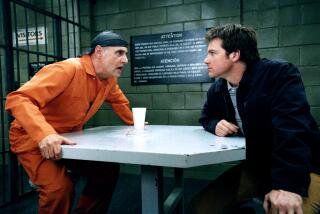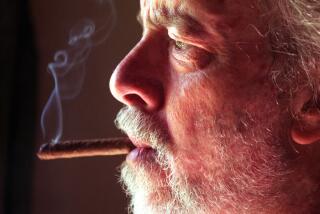Cause of a ‘Break-Up’
- Share via
With a movie such as “The Break-Up” beset during production by a swirl of panting tabloid coverage and then released amid a flurry of are-they-or-aren’t-they speculation regarding its stars Jennifer Aniston and Vince Vaughn, the actual thing at the center of it all, the filmic object, as it were, can easily be forgotten.
Somewhere underneath the frenzied rumor-mongering, salacious conjecture and early prognostication there is still a movie, after all. The director of that movie is Peyton Reed.
Though all three of his feature films to date -- including “Bring It On” and “Down With Love” -- can ostensibly be classified as comedies, beyond that they are rather far afield from one another, connected largely by the director’s visual flair and seeming acuity with actors.
As Reed recently explained, the catalyst for his latest film was largely Vaughn’s desire to make a film apart from the usual romantic comedies he was being sent, to inject a bit of real-life struggle and heartbreak into the usual structure of boy-meets-girl, boy-loses-girl, boy-struggles-to-win-girl-back. Besides costarring, Vaughn also receives a co-story credit and is one of the film’s producers.
Fairly early in the film, the main characters, a cohabitating couple, reach a breaking point and decide to go their separate ways as soon as the issue of their condominium can be settled. Some early reviews have noted that the characters of Gary and Brooke (played by Vaughn and Aniston) in their mundane bickering about doing the dishes and filling the ice cube trays are unlikable within the conventional vernacular of Hollywood rom-coms.
Reed noted that this was largely on purpose, as Vaughn was attempting to deconstruct somewhat his screen image as a caddish party-boy. Anyone expecting “Wedding Crashers 2,” though, may be in for something of a shock, as Reed’s film walks a tightrope that puts laughs on hold in an attempt to engage with the characters on a more genuine emotional level.
“Vince doesn’t mind laying himself bare a little bit,” said Reed, “and appearing, behavior-wise, ugly. Obviously Vince isn’t Gary. But the idea that he’s a man, but a large part of him is still a boy, playing at being a man, I find that really sort of relatable for this generation of guys. When our parents were in their mid-30s, they were married and had kids and were very responsible.
“And this is just a different generation and you do have adult guys coming home to play video games. Vince is in some ways the poster child for that generation, the positives and the negatives of it.”
Reed’s first feature, “Bring It On” (2000), was a surprise success at the box office and with critics alike. A high school picture that moved with the bounce of a musical, it was one of the key pictures in Kirsten Dunst’s transition from child actor to full-fledged stardom. Alongside its rather nuanced take on issues of race and class among the TRL set, it should be noted that the film included an ending in which the heroine lost.
Reed’s second picture, 2003’s “Down With Love,” which he jokingly referred to as “a cult classic on arrival” and his “difficult second album,” didn’t spark with audiences in the same way. A self-conscious revamp of the Rock Hudson-Doris Day war-of-the-sexes pictures, with a keen eye to period styling, it was nevertheless Reed’s unlikely calling card for “The Break-Up” as it was the film that caught Vaughn’s attention and led him to seek out the director.
From the Chicago locations to Jon Brion’s lushly understated score of chiming guitars and rising pedal steel, Reed gives his latest picture an acute specificity of detail. As well, the supporting cast is fully stocked, including Vincent D’Onofrio as Gary’s inarticulate older brother, Judy Davis as a Mary Boone manquee with an Anna Wintour bob, and the irrepressible Ann-Margret as Aniston’s mother. Both Jon Favreau as Gary’s bawdy buddy and John Michael Higgins as Brooke’s a cappella obsessed brother offer comic relief and balance.
The way in which “The Break-Up” mixes tones, veering between comedy and drama, was slammed by “Variety” as “ill-conceived.” But in Reed’s view, it’s “real.”
“I think it comes from people getting at a situational comedy that’s, hopefully, more truthful, people who sit around and find more humor and emotional resonance in the stuff that’s going on in their real lives than the stuff that’s going on in the movies. What I loved about ‘The 40 Year-Old Virgin,’ the title is the easy sell, but when you see the movie the comedy is more free-form and more relatable.”
Affable and unassuming in person, Reed, 41, is perhaps an unlikely lightning rod for discussions of generational conflict within the ranks of filmmakers. However, an impassioned battle erupted recently in the comments section on critic Dave Kehr’s website over how to deal with a director like Reed.
The pro side advanced that he is the current analog to revered older directors, able to engage with studio assignments in such a way as to render them more witty, lively and enjoyable than they might otherwise turn out. The con side downgraded him as simply another cog of the modern-day multinational Hollywood machine.
Kehr, via e-mail, noted that he was surprised by the rancor Reed’s work had set off.
Among the pre-release press “The Break-Up” has garnered, many have noted that the ending was re-shot, often taken as a sign of a production in trouble.
Reed said finding the right tone for the ending of the film was a difficult process. “We shot a lot of stuff. We shot a lot of different versions, with the assumption that we’d find it in the editing room. A handful of frames too long on one person means one thing, and a cut too abruptly means another. It was really unlike anything I’ve directed or edited, really fragile and really malleable. You had to be careful with it.”
The actual do-they-or-don’t-they of the ending is being treated, in the parlance of our times, as a spoiler. Suffice it to say that the ending ultimately comes from the same impulses as the rest of the film, looking to tinker with audience expectations of what a glamorous Hollywood romantic comedy can be and do.
Acknowledging the difficulty of talking about something without talking about it, Reed said, “I think with any movie, the more you know, it loses some of its power. But it is one of the most interesting aspects of the movie, I think, and we toyed with other versions of the ending and we ended up with what these characters told us they wanted the ending of the movie to be.
“So much has been talked about, do they end up together, do they not, and to me that was less important than how [the relationship] affected the characters as individuals, how the experience of that relationship made them grow as individuals and what they’ll carry with them into the future. I like that as a dramatic thrust to a movie.”
More to Read
Only good movies
Get the Indie Focus newsletter, Mark Olsen's weekly guide to the world of cinema.
You may occasionally receive promotional content from the Los Angeles Times.











